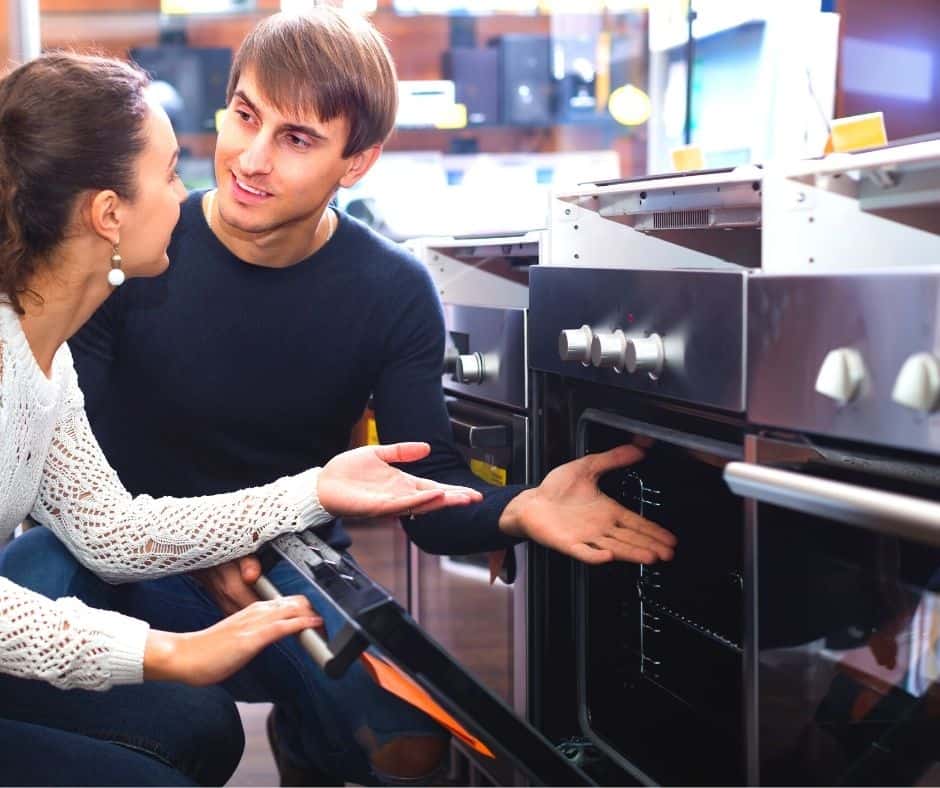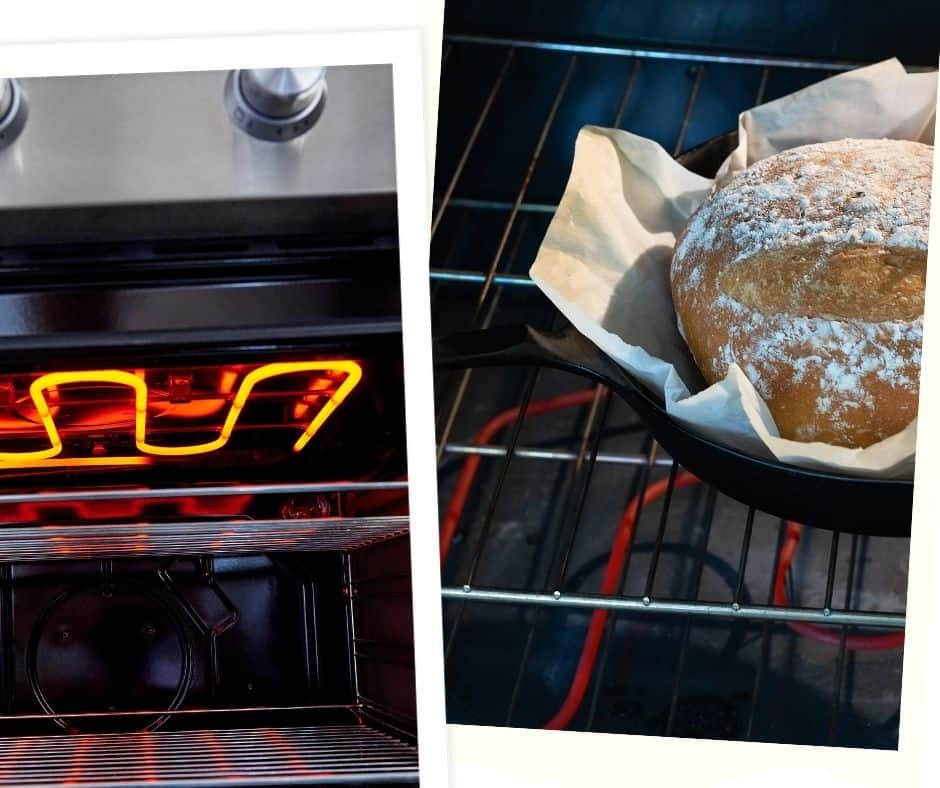An oven is an essential appliance in any kitchen, especially if you are an avid baker. If you are not sure whether to get a fan or a conventional oven for baking cakes, here are some different factors to consider before making a purchase.
What Is The Difference Between Fan And Conventional Ovens?

The difference is the heat distribution. In a regular conventional oven, the stationary heating element radiates the heat from the top and bottom of the oven. The heat from convection or fan-assisted ovens is blown and circulated by fans using forced convection.
So, let’s take a closer look at each appliance.
What Is A Conventional Oven?

In a conventional oven, the heat is generated by the top (bake element) and/or bottom (broil) heating elements. It does not have a fan, and these ovens are generally the cheaper ovens on the market. A conventional oven can be either gas or electric.
As there is no extra method of distributing the hot air around the oven, these ovens can often have both hot and cold spots. This is why chefs and bakers have to open the oven and turn the cakes around when they are using conventional ovens.
During bake time, you should open the oven door as little as possible to make sure the temperature doesn’t fluctuate too much.
Letting cold air in the oven can cause your cake or bread to collapse in the middle, affecting the rise, increasing the cooking time, and possibly reducing the texture, quality, and taste of the cake.
However, despite having to turn the cakes during baking, some bakers are still very much firm supporters of the conventional oven.
What Is A Convection Oven?

A convection oven, or a fan-assisted oven, has a built-in fan inside it. The fan distributes the heat evenly throughout the oven. The fan is at the back of the oven. It blows heat generated from the heating elements throughout the inside of the oven. Convection ovens are also available in gas or electric models.
However, a true fan-assisted oven has a fan with a heating element around it, and these types of fan ovens are always electric. True fan-assisted ovens and convection ovens have an even heat distribution as the heat is pushed around by the fan consistently throughout the entire baking time.
Due to the even heat distribution, these ovens cook more evenly. However, you do have to reduce your baking time by about 10 minutes, as well as reduce the temperature by 68°F (20°C).
Chefs generally love these types of fan-assisted ovens as they can reduce cooking times by up to 25%.
Fan-Assisted or Conventional Oven – Which One Is Better For Baking Cakes?

Fan-assisted and conventional ovens are both perfectly capable of baking cakes. Although conventional settings could be more suitable for delicate baking projects, it is a good idea to buy a fan-assisted oven with both conventional and convection functions, which provides more cooking options.
As with anything, conventional ovens, and fan-assisted ovens both have pros and cons when it comes to baking cakes.
As I mentioned briefly above, conventional ovens, those that don’t have fan assistance, can often have cold spots and hot spots in the oven. This means that you sometimes have to turn the cakes halfway through. These ovens also require very exact placement of the cakes to get the best results.
As a general rule of thumb, when it comes to placing cakes, the thinner the cake layer, the higher up the oven it should go. The thicker the cake layer, the further down it should go.
Fan-assisted ovens sound like they would be better for baking as they have a more even temperature due to the fan pushing the air around. However, the air in these ovens tends to be much dryer, so much so that in modern ovens, they are beginning to introduce different ways of adding moisture back into the air.
As such, fan-assisted ovens are not good for particular cakes such as sponge cakes and are also not recommended for cookies. Due to the faster cooking time, they have drawbacks, such as the outside of the cake cooking much faster than the inside of the cake.
Sometimes the difference in the bake time can be so pronounced that the top of the cake flops over, sinks, or turns gummy in the middle, and the cake is dry and tasteless on the outside before it is even done on the inside.
Fan Assisted Oven vs. Conventional Oven
Fan Assisted-Oven
Pros:
- Evenly baked cakes because of the even heat distribution.
- Faster baking time.
- More suitable to cook multiple cakes or dishes at the same time as the oven heats it as a single dish.
- You don’t have to worry about where to put your baking tray in the oven because heat is distributed evenly throughout the oven.
- Fan-assisted ovens are more energy-efficient because of the shorter cooking times, and you can use lower temperatures than you would in a conventional oven.
Cons:
- Most baking recipes are meant for traditional or conventional ovens, so you must change and experiment with temperature and cooking times.
- Heat can be too harsh for gentler baked goods like bread, flaky pastries, and cakes.
- They have a tendency to be noisy.
- Dough may not rise well enough because of the harsh heat and faster cooking time.
- Shorter lifespan and higher repair cost than traditional or conventional ovens.
- They could dry out your cake because convection ovens are likely to lose steam, and the fans eviscerate the moisture out of the air in the oven.
Conventional Oven
Pros:
- Most recipes and baking times and temperatures are written for conventional ovens.
- Greater ease of use and familiarity because of fewer settings, and many have grown up using traditional or conventional ovens.
- A better option for more delicate cooking.
- Cakes and bread would get a better rise; that is why many bakers still prefer these types of ovens.
- Cheaper to buy and lasts longer.
Cons:
- Baking in conventional ovens requires more care and attention because of the air pockets and uneven heat distribution.
- Longer baking times.
- Less efficient and requires more electricity or gas to preheat and maintain the temperature.
Tips To Get The Best From Your Baking:
- Preheat the oven to make sure the air inside is at the correct temperature from the beginning. With fan-assisted ovens, the preheat time will be a few minutes.
- With conventional ovens, the preheating time is anywhere between 10-15 minutes.
- If in doubt, use the middle shelf. Thinner layers should go above the center of the oven; thicker layers and deep loaves should go below the center.
- Find an easy and delicious cake recipe that is highly recommended or tried and tested by a source you trust.
- Make sure to get the best quality ingredients.
- Sponge cakes and very liquid batters should be baked long and slow. If possible, only use a conventional oven for baking these cakes and only use the bottom element.
- Make sure you don’t hinder airflow by putting too many trays or pans that are too large in the oven. Air circulation is vital to the success of your baking.
- Stagger cake tins and do not put them directly beneath one another while baking.
- Make sure cake tins do not touch each other or the sides of the oven.
- If you know you have hot spots in your oven, wait until they’re nearly ready to take out, and then swap the tins around for even baking.
- If your oven has a fan in it, and it has the option of turning it off, turn the fan off when baking cakes. For larger cakes, only use the bottom element in the oven.
Read Also: 11 Best Loaf Pans For Baking Bread And Cakes
Conclusion
If you are going out to buy a new oven and trying to decide which one would be best for you, allow me to point you to some sage advice.
The Queen of the Kitchen herself, Miss Nigella Lawson, suggests that “fan-assisted ovens which provide both conventional and convection functions is the most flexible solution.”
This is rather good advice as it allows you the best of both worlds.
